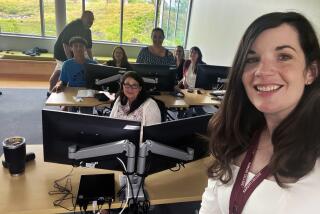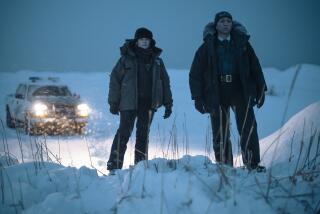Bones of Contention : WITNESSES FROM THE GRAVE: The Stories Bones Tell <i> By Christopher Joyce and Eric Stover (Little, Brown: $19.95; 352 pp.) </i>
- Share via
I will never again take off or land with a ball-point pen in my breast pocket. In a crash landing, this innocent tool of the writer’s trade could penetrate the heart much like an ice pick, greatly reducing one’s chances of escaping the wreck. Clyde C. Snow, at one time the physical anthropologist at the Federal Aviation Administration’s Civil Aeromedical Institute, saw enough evidence of this in all the plane crashes he helped reconstruct that whenever he flies he carefully slips his pen in with the safety literature and airline magazine in the seat pocket in front of him.
In the world of applied physical anthropology, specifically forensic anthropology, Snow is without peer. When an airline-crash or crime victim has been reduced to nothing but bones, or pieces of bones, Snow often can determine who the victim was and what happened, where others fail. Former Los Angeles County Medical Examiner Thomas Noguchi was fond of saying that the autopsy was the opportunity for the victim of a crime to testify--”The victim is talking to you,” Noguchi would say. Snow listens to bones. “Witnesses From the Grave: The Stories Bones Tell” by Christopher Joyce and Eric Stover is Snow’s story.
It also is the story of forensic anthropology, which dates back in this country to about 1850. When Dr. George Parkman paid a visit to a colleague at the Harvard Medical School to collect a debt, part of him ended up in Dr. John White Webster’s privy. Police found a human thorax, a sternum and ribs of an upper torso in a tea chest, and in the stove Dr. Webster used to heat chemicals were a set of false teeth. Physicians and dentists from Harvard were assembled to sort through the mess in an attempt to identify the remains as Parkman.
Oliver Wendell Holmes, then dean of the Harvard Medical College, was joined on the panel by Dr. Jeffries Wyman, professor of anatomy at the university. They were able to conclude that the remains were human and belonged to one person about the same age, height and build as Parkman. It was the dentures retrieved from the stove and the testimony of Parkman’s dentist, Dr. Nathan Keep, that sent Webster to the gallows, despite the contrary testimony of another dentist, Dr. William T. G. Morton, the man who discovered ether. Boston had been so taken by the trial that viewers were rousted and replaced every 10 minutes. By trial’s end, 55,000 Bostonians had peeked at the proceedings.
As though lifted from the pages of Edgar Allen Poe, Paris became the center for advances in forensic anthropology at the turn of the century. Systems were carefully developed and espoused for determining criminality by physical characteristics. An offshoot of this false start, however, was the compiling of so much hard data on the skeletal system, including measurements of men and women of all ages, that statistically relevant tables eventually could be constructed. Clyde Snow is able to say a pelvis is that of a female of a certain age because statistically, given the measurements and other evidence, it should be so.
Much of the criminal-identification procedure used in Europe by physical typing, however, became outmoded with the British invention of fingerprinting, a much more exact means of identification.
Wars have been of particular use to forensic anthropologists for putting into their hands significant numbers of skeletal remains. Mildred Trotter was tapped by the Army in 1946 to set up shop in Hawaii to identify war dead brought in from Guadalcanal, Iwo Jima and the Philippine jungles. She convinced her colleagues that as important as identification might be, measuring all the bones of the dead and compiling records for future statisticians was absolutely vital. T. Dale Stewart repeated the exercise in the Korean War, then went on to tutor the FBI in forensic anthropology.
Snow just missed serving in the Korean War. He had grown up in Texas and New Mexico, the son of a doctor, traveling rounds with his father, helping with the birth of babies, watching people die. He finished high school at a rigorous New Mexico military academy in a failed attempt to harness his wild side, then proceeded through a college career that shifted from zoology to medical school and back to zoology, then to archeology and finally anthropology, all the time reading the great poets, boozing, chasing skirts and smoking heavily.
He first made a name for himself at the FAA’s Civil Aeromedical Institute with studies that led to the redesign of seat-restraint systems, particularly for the airline cabin staff, as well as escape systems on commuter aircraft. As “the cowboy profesor,” Snow lectured in anthropology at the University of Oklahoma, and eventually caught the attention of the Oklahoma medical examiner, his entree into a career in crime investigation.
In his career, Snow would attend to some of the more famous air tragedies as well as famous murder cases, including the John Wayne Gacy affair. When the Brazilians thought they had found the bones of Joseph Mengele, Snow was among the international panel of experts who agreed on the identification. Even more compelling--and perhaps most important--is the story of Snow’s work at the mass grave sites of the “disappeared” of Argentina, giving back identities to the dead as well as compiling statistically relevant data demonstrating how a government slaughtered its own youth.
“Witnesses From the Grave” is a fascinating story. Clyde Snow should leap off the page, but unfortunately he doesn’t. Where the writing should crackle it unfortunately puddles along, falling into one chasm of cliche after another.
Forgive the writers their sins and read instead for the opportunity to peek behind a door too often closed to the public.
More to Read
Sign up for Essential California
The most important California stories and recommendations in your inbox every morning.
You may occasionally receive promotional content from the Los Angeles Times.










